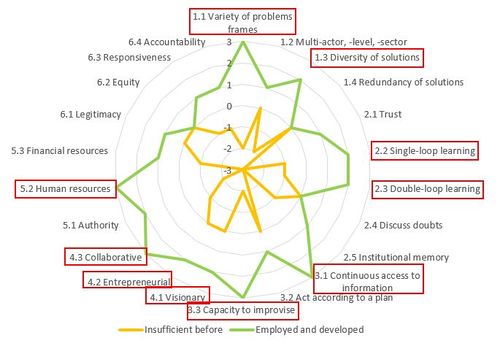Critical infrastructure
What is critical infrastructure?
The EU (2008) defines critical infrastructure as ‘an asset, system or part thereof located in Member States which is essential for the maintenance of vital societal functions, health, safety, security, economic or social well-being of people, and the disruption or destruction of which would have a significant impact in a Member State as a result of the failure to maintain those functions’.
Critical infrastructure and FRAMES
Within FRAMES, the vulnerability of critical infrastructure assets to floods was assessed in three pilot projects: electricity grid networks in Reimerwsaal and Flood Proof Electricity Grid Zeeland pilots in the Netherlands and social and care home sectors in the Kent (United Kingdom).
How is critical infrastructure linked to the layers of MLS?
The knowledge gained from the three pilot projects looking at critical infrastructure are linked as follows to the layers of the MLS approach:
- Layer 2, spatial adaptation: limits flood consequences (a) when applying spatial adaptation measures for vulnerable electricity grid assets
- Layer 3, emergency management: supports preparedness and emergency planning by (a) raising flood risk awareness of about the vulnerability of critical infrastructure; (b) update local flood action plans including evacuation routes and risk communication strategies based on updated flood risk maps; (d) update asset management plans;
- Layer 3, resilient recovery: when flood preparedness measures are taken this leads to a better flood recovery for communities.
Lessons learnt
The main lessons learned when assessing the vulnerability of critical infrastructure to floods are:
Relevant adaptive capacities needed
To accomplish actions successfully, certain capacities are more needed than others. More specifically: the combination of flood risk management strategies in response to climate change depends on the adaptation space and capacity of institutions (Berkhout, Hertin and Gann, 2006). Since institutions have the ability to stimulate the capacity of a society to adapt to climate change from the local to the national level (Gupta et al., 2010), stakeholders and organizations involved in FRAMES focused on the development of adaptive capacities at local and regional level.
The adaptive capacities that were employed and developed during the pilot projects working on community resilience are shown in the spiderweb below. We will provide more detail for those capacities that significantly increased during the pilots.
- Variety of problem frames: prepare an in-depth analysis of the problem. A flood directly causes failure of the electricity grid network but also has indirect, or cascading effects on vital services such as transportation and telecom services. Therefore, an in depth problem analysis is required to consider the perspective of all stakeholders involved in the management of critical infrastructure.
- Human resources: create new knowledge. The pilot projects resulted in new knowledge gained about the vulnerability of critical infrastructure in relation to flood scenarios.
- Diversity of solutions: consider multiple measures. The knowledge generated in the pilot projects provide diverse solutions in FRM (e.g. spatial adaptation and preparedness measures).
- Continuous access to information: make information available for all stakeholders. This knowledge and information is made available for organizations involved in managing critical infrastructure, but also municipalities and policy makers.
- Collaborative leadership: authorities of all levels work together on the same issue. As a result of these pilot projects, collaboration between crisis management organizations, critical infrastructure owners and local authorities (local and regional) improved.
- Visionary leadership: let all stakeholders share their insights. All stakeholders together discussed challenges and shared a common vision for the long term planning of critical infrastructure in relation to climate change.
- Capacity to improve: be more flexible when it comes to actions and solutions. Moreover, critical infrastructure owners increased their capacity to deal with flood risk in the long term.
- Entrepreneurial leadership and single loop learning: do something with the new knowledge to make improvements. Critical infrastructure owners are motivated and interested to integrate the gained knowledge gained to improve the current asset management plans of the critical infrastructure.
- Double loop learning: integrate new knowledge into policy. This knowledge was also translated into policy advice to start up a discussion with policy makers and include this topic into the political agenda. For instance, in the Electricity grid network Zeeland and Wesermarsch, flood risk assessments of critical infrastructure and importance of layer 3 (emergency response) have been put on the political agendas.
Toolkit
The following tools were used in these pilot projects:
- Stakeholders analysis
- Workshops
- National information system Water and Floods, LIWO (Landelijk Informatiesysteem Water en Overstromingen)
- Cost-benefit Analysis (CBA)
- Vital Asset tool
- 3D modelling of flood risk scenarios
- Critical Infrastructures: Relations and Consequences for Life and Environment (Circle)
- Risk label method
- 3D viewer of flood scenarios
- Mobile app
- Evacuation traffic model
- The Kent Strategic Health Asset Planning and Evaluation (SHAPE) Atlas
- Severe Weather Impacts Monitoring System (SWIMS)
- KentView
- Climate Just
- Climate Change Risk and Impact Assessment (CCRiA)
- Social media for dissemination
Referenties
- Stakeholder analysis report FRAMES, FRAMES Consortium, 1 januari 2020.
- Adaptive capacities FRAMES definitions and examples, Gupta et al, 20 april 2020.
Hier wordt aan gewerkt of naar verwezen door: Layer 2- Spatial adaptation

